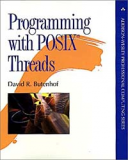Книга: Programming with POSIX® Threads
1.6.3 Programming model
1.6.3 Programming model
It may be surprising that programming with threads is a good idea even if you know your code will never run on a multiprocessor. But it is true. Writing with threads forces you to think about and plan for the synchronization requirements of your program. You've always had to think about program dependencies, but threads help to move the requirements from comments into the executable structure of the program.
Assembly language programs can use all the same sequential control structures (loops, conditional code) as programs written in a high-level language. However, it can be difficult to determine whether a branch instruction represents the top or bottom of a loop, a simple conditional, a "conditional goto," or something more exotic. Switching to a higher-level language that supports these sequential controls directly in source, for example, the C language do, while, for, if, and switch statements, makes these sequential programming constructs explicit in the source language. Making control structures explicit in the program source code means that more of your program's design is explicit in the source, and that makes it easier for someone else to understand.
Similarly, a C language program (or even an assembler program) may use data encapsulation and polymorphism by adhering to programming conventions, and with luck those conventions may be carefully documented and the documentation kept updated. But if that same code is written in an object-oriented language, the encapsulation and polymorphism become explicit in the source language.
In a sequential program, synchronization requirements are implicit in the ordering of operations. The true synchronization requirements, for example, that "a file must be opened before data can be read from the file," may be documented only by source comments, if at all. When you program using threads, sequential assumptions are (or at least should be) limited to small segments of contiguous
code—for example, within a single function. More global assumptions, to be at all safe, must be protected by explicit synchronization constructs.
In traditional serial programming you call function A to do one thing, then call another function B to do something else, even when those two functions don't require serialization. If a developer is trying to determine what the program is doing, perhaps to trace a bug, it often isn't obvious that there may be no need to follow both calls. Furthermore, the strictly serial model makes it easy for someone to inadvertently make function B dependent on some side effect of function A. If a later modification reverses the order of the calls, the program may break in ways that aren't obvious. Program dependencies may be documented using source code comment blocks, but comments are often ambiguous and may not be properly updated when code is changed.
The threaded programming model isolates independent or loosely coupled functional execution streams (threads) in a clear way that's made explicit in the program's source code. If activities are designed as threads, each function must include explicit synchronization to enforce its dependencies. Because synchronization is executable code, it can't be ignored when dependencies are changed. The presence of synchronization constructs allows anyone reading the code to follow temporal dependencies within the code, which can make maintenance substantially easier, especially for large programs with a lot of independent code.
An assembly language programmer can write better, more maintainable assembly code by understanding high-level language programming; a C language programmer can write better, more maintainable C code by understanding object-oriented programming. Even if you never write a threaded program, you may benefit from understanding the threaded programming model of independent functions with explicit dependencies. These are "mental models" (or that dreadfully overused word, "paradigms") that are more or less independent of the specific code sequences you write. Cleanly isolating functionally independent code may even make sequential programs easier to understand and maintain.
- 6.3. CONSISTENCY MODELS
- 6.3.8. Summary of Consistency Models
- 1.1.6 Hardware and Software Co-Design Model
- 1.1.4. Model Explorer - навигатор модели
- PART V Programming Linux
- Programming in C
- Using the C Programming Project Management Tools Provided with Fedora Linux
- 3.4.2. The Transaction Model
- 14.4.1. Programming Flash Using a JTAG Probe
- 17.2.2. Preemption Models
- 3.2 PIC Microcontroller Input-Output Port Programming
- 3.3 Programming Examples




